Nebulae and Stellar Birth
Stellar nurseries are made of clouds of dust and gas called nebulae (singular
is nebula). All stars are born out of nebulae -- except in some rare
instances when two neutron stars merge to form
a black hole (however, both neutron stars
and black holes are considered to be "dead" stars).
There are two different origins of nebulae. The first origin
for material is the universe's creation itself: Soon after its birth, atoms were
created in the universe, and it is from these that the first dust and gas clouds
formed. This means that the gas and dust that make up this type of nebula were
not created in a star, but are the original matter from the beginnings of the
universe. The second kind of nebulae are produced by the supernovas
of exploding stars. The matter ejected from them created the Veil and Crab
nebulae, as well as many more. Also, keep in mind that the origins of nebulae
are not as clear cut as this; a nebula can be a mixture of primordial material
as well as new material from previous stars.
| Emission |
Emission nebulae are the most colorful of the five
main types of nebulae. They are lit internally from young stars still in their
stellar nursery. The different colors are caused by the different gases and
the composition of the dust in the nebula. Usually a large telescope (8+ inches)
will reveal most of the colors in an emission nebula. To see all of the colors,
a long-exposure photograph is usually required.
Pictured to the right is a section of the Eagle Nebula (top)
and the Lagoon Nebula (bottom). In the image of the Eagle Nebula, also known
as M16, one can see three distinct "pillars" of gas. It took the
Hubble Space Telescope to see these pillars, imaged in 1995, and they would
not be visible to back-yard astronomers. Inside the pillars are newly-formed
stars, whose solar winds are literally blowing away the surrounding gas and
dust. The most prominent pillar is about 10 light-years tall
and one light-year thick. The full nebula was discovered in 1764, and lies
about 7,000 light-years away.
The image of the Lagoon Nebula (M8) is also taken by the
Hubble Space Telescope. It lies approximately 5,200 light-years away, and
was originally discovered in 1747. The full nebula spans approximately 140x60
light-years, but this is just a small section of it that Hubble imaged.
|
 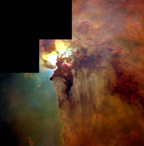 |
| Reflection |
Reflection nebulae are nebulae that reflect stars'
light - stars from either inside or near the nebula. The Pleiades (pictured
to the side) is a good example of a reflection nebula. The stars are thought
to have formed at roughly the same time - about 100 million years ago, which
would make them about 1/50 the age of our sun. They are believed to currently
be plowing through the thin, wispy nebula that is seen as blue wisps and glows
around the stars (the flares are artifacts of the camera).
|
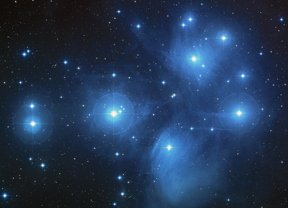 |
| Dark |
In essence, all nebulae are in fact dark, for they
produce no visual light of their own. However, when astronomers refer to a "dark
nebula," they are speaking of one that blocks the light of something
behind it, like a wall, and are thus only visible when they omit light from
something behind them (from our line of sight). That is why we cannot see
very far into our galaxy in visible light - there are too many lanes of dust
and gas (dark nebulae) in the way, so astronomers must rely on other forms
of light.
Pictured to the right is the famous Horsehead Nebula, this
image taken by the Hubble Space Telescope. The part that forms the horse's
head is the dark nebula, known as Barnard 33. The dark nebula lies in front
of the background emission nebula, known as IC 434.
|
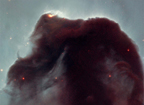 |
| Planetary |
Planetary nebulae are created when a main
sequence star grows into a red giant and
casts off its outer layers. This is how they get their (usually) circular
shape, for the material is thrown off the star in a roughly symmetrical
manner, as seen in the upper picture of The Cat's Eye Nebula (NGC 6543).
You can also see the remains of the central star in this image.
In the case of the lower image of the Retina Nebula (IC 4406), we are viewing
the circular disk on its side, like looking at a doughnut's edge. The star's
spin and magnetic fields cause the material to expand in more of a circular
disk, rather than in a spherical manner.
The term "planetary" comes from the nineteenth
century, when astronomers saw that they looked vaguely like the newly-discovered Uranus and Neptune in
their primitive telescopes. (Remember that this was a time before people knew
that there were different galaxies.) The name has stuck ever since.
|
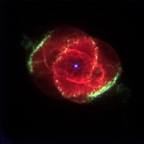  |
| Supernova Remnant |
These nebulae are the creations of ancient supernovas -
the violent explosions of massive stars at the end of their lives. The most
famous example is the Crab Nebula, created by a well-documented supernova
on July 4, 1054.
The supernova remnant pictured to the right was taken by the Hubble Space
Telescope of nebula N132D in the Large Magellanic Cloud - a small, satellite
galaxy of the Milky Way.
|
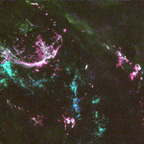 |
The first step in the birth of a star is to wait. Dust, gas,
and other materials sit around in nebulae, and wait for possibly millennia until
a passing star, or some other heavy body passes by and stirs things up a bit.
When a heavy body passes near or through the nebula, its gravity
causes swirls and ripples. It would be like spreading marbles out on a trampoline,
and then rolling a large lead ball around the edge, or through the middle. The
other marbles would roll around, and clump together near the path the lead one
took. It is no different in a nebula when a star passes by. To add to the marble
analogy: When the marbles gather in places, the dip in the trampoline causes
other marbles to accumulate in the same spot until there are just a few piles
of marbles, with few in between. This process is called "accretion."
The "piles" of matter continue to group together
in the nebula until they are gigantic clumps of dust and gas. At this stage,
the clump is called a protostar.
As the protostar becomes larger, gravity squeezes it tighter, causing pressure
to build and for the heat to increase. If you have ever pumped a bicycle tire,
you know that when the air becomes compressed, it becomes hotter.
Then, when the pressure in the center, the core, reaches
a temperature of 10,000,000 K (18,000,000° F), hydrogen fusion is initiated.
Now, the protostar has become a star. It shines with its own light. Its solar
wind quickly pushes away the rest of the dust and gas in its vicinity.
NOTE: A protostar that does not become
hot enough to begin fusion, yet is no longer surrounded by its parent nebula
is called a brown dwarf. A brown dwarf usually has between 1/12 and 1/100
of the sun's mass. It can still produce heat by contracting very slowly (i.e.
decreasing its equatorial diameter by a few millimeters a year), yet does not
shine as a star does. Jupiter produces heat in this
way, although it is too small to be considered a brown dwarf. Most brown dwarfs
have an average surface temperature of 1,800 K (2,700° F). There are an estimated
one trillion brown dwarfs in our galaxy alone, and some think they may be a source
of the universe's missing mass.
|



